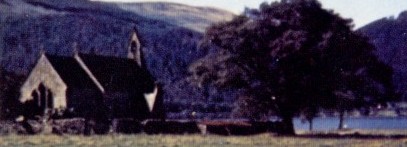
The Parish church of St. Bega at Bassenthwaite is a building of considerable historical and architectural interest. Stands about 200 yards from the edge of Lake Bassenthwaite. There is only a track to the church and the last 100 yards you must walk. Built in the simplest Normal style, and most important, for at least 900 years this church has served the spiritual needs, not just of the parishioners of Bassenthwaite, but also in former times of the wayfarers, and now of the holiday makers.
In 1294 a vast return of the finances of all the parishes in England was carried out on the direction of Pope Nicholas IV. In this return, known as the "taxatio Ecclesiastica", Bassenthwaite parish is mentioned. Again, in 1302, John de Halton, Bishop of Carlisle, listing the churches in his diocese, refers to St. Bega's as "Bechokirk". In the lay subsidy rolls for the year 1333, the name of our first known parish priest is recorded. Under "Baste nthwait" in the rolls is listed "Dom. John Capellanus de Bengokirk", and his annual income is given as £7-0-0 ($14.00).
The last surviving mention of the church during this period is to be found in the will of Sir Adam de Bastenthwait. In his will, made on 13th December, 1358, Sir Adam made arrangements for prayers for his soul to be said in the "Parish Church of St. Bega de Bastenthwayt". In the will the church is also referred to as "Beghekirk".
Little survives of the history of the parish during the Tudor period. The civil affairs of the parish were largely directed by the Earls of Derby, who built a lodge at Mirehouse, which stands near the church. They had become lords of the manor, when, late in the fourteenth century, the heir of the de Bassenthwaite family was convicted of treason, thereby forfeiting all his estates. Unfortunately the manorial records of the period have not survived.
Restoration of the church was completed in 1874. The exterior of the church was completely renovated in the Gothic style, but fortunately the valuable Norman features of the interior were carefully preserved and restored. The church has stood unchanged from 1874 to the present day (1977).
| « NEXT » | « Bassingthwaighte » | « Citizens » | « Jandowae » |
|---|